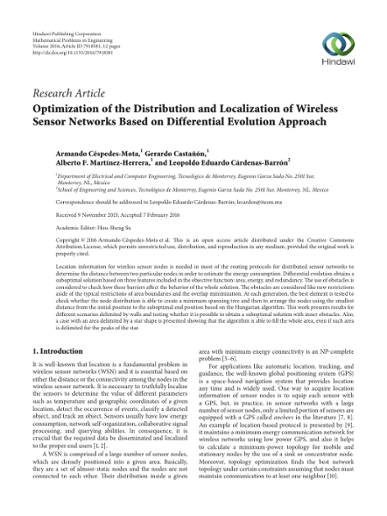| dc.creator | Alberto Francisco Martínez Herrera | |
| dc.creator | Leopoldo Eduardo Cárdenas Barrón | |
| dc.creator | Gerardo Antonio Castañón Avila | |
| dc.creator | Armando Céspedes Mota | |
| dc.date | 2016 | |
| dc.date.accessioned | 2018-10-18T20:12:58Z | |
| dc.date.available | 2018-10-18T20:12:58Z | |
| dc.identifier.issn | 1024123X | |
| dc.identifier.doi | 10.1155/2016/7918581 | |
| dc.identifier.uri | http://hdl.handle.net/11285/630343 | |
| dc.description | Location information for wireless sensor nodes is needed in most of the routing protocols for distributed sensor networks to determine the distance between two particular nodes in order to estimate the energy consumption. Differential evolution obtains a suboptimal solution based on three features included in the objective function: area, energy, and redundancy. The use of obstacles is considered to check how these barriers affect the behavior of the whole solution. The obstacles are considered like new restrictions aside of the typical restrictions of area boundaries and the overlap minimization. At each generation, the best element is tested to check whether the node distribution is able to create a minimum spanning tree and then to arrange the nodes using the smallest distance from the initial position to the suboptimal end position based on the Hungarian algorithm. This work presents results for different scenarios delimited by walls and testing whether it is possible to obtain a suboptimal solution with inner obstacles. Also, a case with an area delimited by a star shape is presented showing that the algorithm is able to fill the whole area, even if such area is delimited for the peaks of the star. © 2016 Armando Céspedes-Mota et al. | |
| dc.language | eng | |
| dc.publisher | Hindawi Publishing Corporation | |
| dc.relation | https://www.scopus.com/inward/record.uri?eid=2-s2.0-84962467341&doi=10.1155%2f2016%2f7918581&partnerID=40&md5=f8e283c916fdbcdb081508716969c612 | |
| dc.relation | Investigadores | |
| dc.relation | Estudiantes | |
| dc.rights | info:eu-repo/semantics/openAccess | |
| dc.rights.uri | http://creativecommons.org/licenses/by-nc-nd/4.0 | |
| dc.source | Mathematical Problems in Engineering | |
| dc.subject | Energy utilization | |
| dc.subject | Evolutionary algorithms | |
| dc.subject | Optimization | |
| dc.subject | Power management (telecommunication) | |
| dc.subject | Stars | |
| dc.subject | Trees (mathematics) | |
| dc.subject | Wireless sensor networks | |
| dc.subject | Differential Evolution | |
| dc.subject | Distributed sensor networks | |
| dc.subject | Hungarian algorithm | |
| dc.subject | Location information | |
| dc.subject | Minimum spanning trees | |
| dc.subject | Objective functions | |
| dc.subject | Suboptimal solution | |
| dc.subject | Wireless sensor node | |
| dc.subject | Sensor nodes | |
| dc.subject.classification | 7 INGENIERÍA Y TECNOLOGÍA | |
| dc.title | Optimization of the distribution and localization of wireless sensor networks based on differential evolution approach | |
| dc.type | Artículo | |
| dc.identifier.volume | 2016 | |
| refterms.dateFOA | 2018-10-18T20:12:58Z | |



